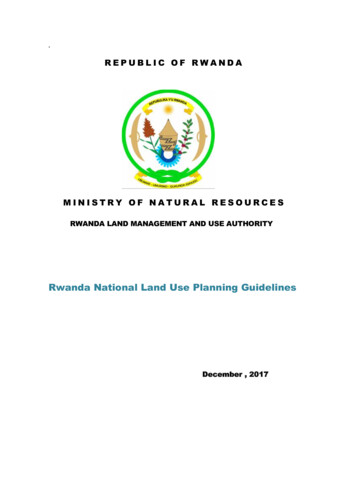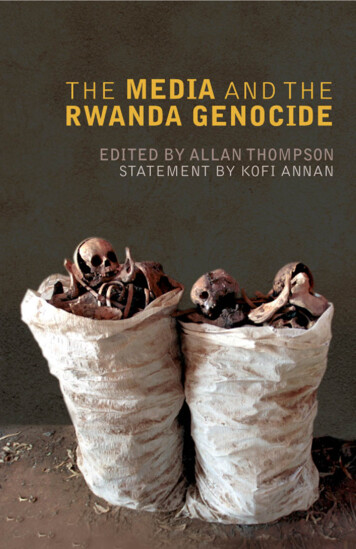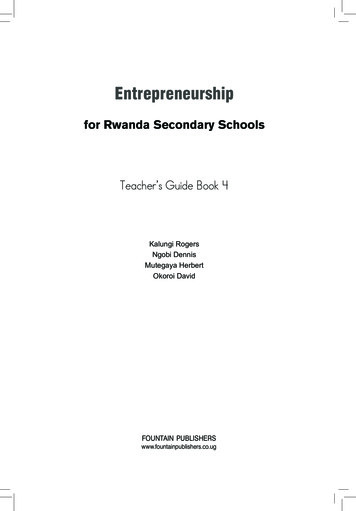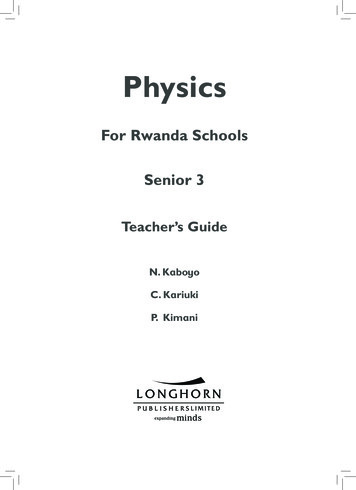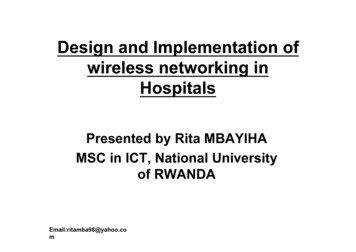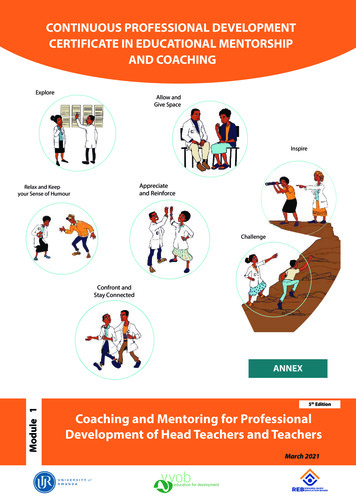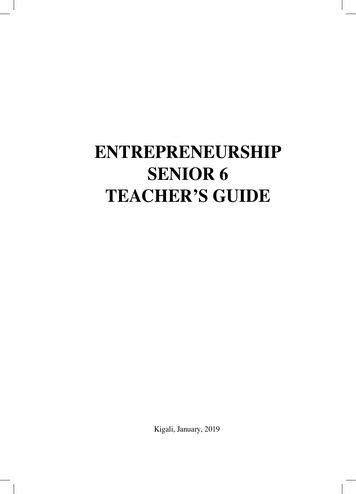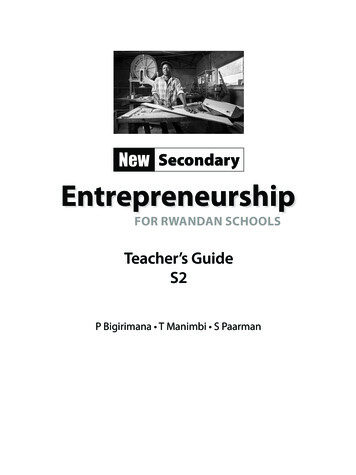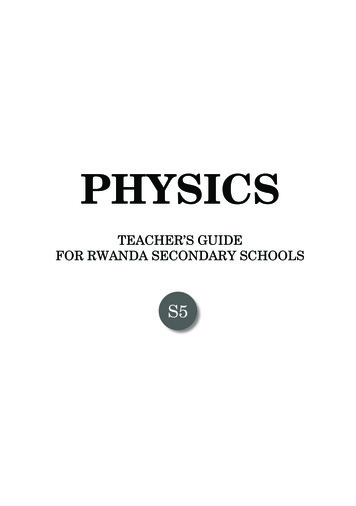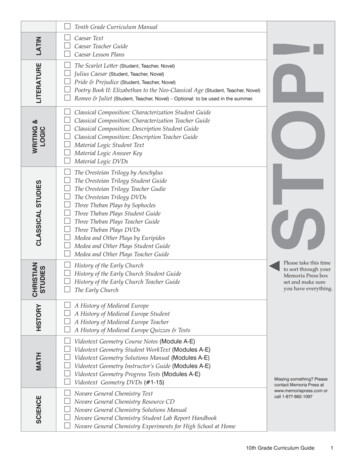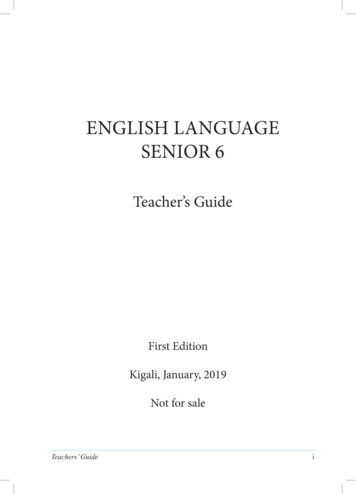
Transcription
ENGLISH LANGUAGESENIOR 6Teacher’s GuideFirst EditionKigali, January, 2019Not for saleTeachers’ Guidei
Copyright 2019 Rwanda Education BoardAll rights reserved.This document is the property of Rwanda Education Board. Credit should be given toREB when the source of this book is quotediiTeachers’ Guide
FOREWORDDear teacher,Rwanda Education Board is honoured to present English language Senior 6 teacher sguide which serves as a guide to competence-based teaching and learning to ensureconsistency and coherence in the learning of the English language subject. TheRwandan educational philosophy is to ensure that learners achieve full potential atevery level of education which will prepare them to be well integrated in society andexploit employment opportunities.In line with efforts to improve the quality of education, the government of Rwandaemphasizes the importance of aligning teaching and learning materials with the syllabusto facilitate their learning process. Many factors influence what they learn, how wellthey learn and the competences they acquire. Those factors include the relevance ofthe specific content, the quality of teachers’ pedagogical approaches, the assessmentstrategies and the instructional materials available. We paid special attention to theactivities that facilitate the learning process in which learners can develop ideas andmake new discoveries during concrete activities carried out individually or with peers.With the help of the teachers, learners will gain appropriate skills and be able to applywhat they have learnt in real life situations. Hence, they will be able to develop certainvalues and attitudes allowing them to make a difference not only to their own life butalso to the nation.This is in contrast to traditional learning theories which view learning mainly as a processof acquiring knowledge from the more knowledgeable who is mostly the teacher. Incompetence-based curriculum, learning is considered as a process of active buildingand developing of knowledge and understanding, skills and values and attitude by thelearner where concepts are mainly introduced by an activity, situation or scenario thathelps the learner to construct knowledge, develop skills and acquire positive attitudesand values.In addition, such active learning engages learners in doing things and thinking aboutthe things they are doing and they are encouraged to bring their own real experiencesand knowledge into the learning processes. In view of this, your role is to: Plan your lessons and prepare appropriate teaching materials. Organize group discussions for learners considering the importance of socialconstructivism suggesting that learning occurs more effectively when the learnerworks collaboratively with more knowledgeable and experienced people. Engage learners through active learning methods such as inquiry methods,group discussions, research, investigative activities and group and individual workTeachers’ Guideiii
activities. Provide supervised opportunities for learners to develop different competencesby giving tasks which enhance critical thinking, problem solving, research, creativityand innovation, communication and cooperation. Support and facilitate the learning process by valuing learners’ contributions inthe class activities. Guide learners towards the harmonization of their findings. Encourage individual, peer and group evaluation of the work done in theclassroom and use appropriate competence-based assessment approaches andmethods.To facilitate you in your teaching activities, the content of this teacher s guide is selfexplanatory so that you can easily use it. It is divided into 3 main parts:The part 1:Starts with general introduction and explains the structure of this bookand gives you the methodological guidance;The part 2:process;Provides the sample lesson plans as reference for your lesson planningThe part 3:Provides details on teaching guidance for each concept given in thestudent book.Even though this teacher s guide contains the answers for all activities given in thelearner’s book, you are requested to work through each question and activity beforejudging learner’s findings.I wish to sincerely appreciate all people who contributed towards the developmentof this teacher s guide, particularly REB staff who organized the whole process fromits inception. Special appreciation goes to the teachers who supported the exercisethroughout. Any comment or contribution would be welcome to the improvement ofthis text book for the next versions.Dr. NDAYAMBAJE IrénéeDirector General of REBivTeachers’ Guide
ACKNOWLEDGEMENTI wish to express my appreciation to all the people who played a major role in the development of this english language textbook for senior five. It would not have beensuccessful without active participation of different education stakeholders.I owe gratitude to different Universities and schools in Rwanda that allowed their staffto work with REB in the in-house textbooks production project. I wish to extend mysincere gratitude to lecturers, teachers and all other individuals whose efforts in oneway or the other contributed to the success in the writing of this textbook.Special acknowledgement goes to the University of Rwanda which provided contentproviders, quality assurers, validetors as well as experts in design and layout services,illustrations and image anti-plagiarism.Finally, my word of gratitude goes to the Rwanda Education Board staff particularlythose from the department of curriculum, Teaching and Learning Resources Department(CTLR) who were involved in the whole process of in-house textbook writing.Joan MURUNGI,Head of Department CTLRTeachers’ Guidev
ContentsFOREWORDACKNOWLEDGEMENTiiiv1. General Introductionix2. Sample Lesson Planix3. Unit Developmentix5. Template of a Competence – Based Lesson PlanxiUNIT 1 : RWANDA AND THE REGION: GEOLOGY11.1 Describing maps31.2 Describing geological features71.3 Describing lakes and rivers151.4 Describing a geological event191.5 Unit Assessment24UNIT 2 : NEWSPAPERS AND REPORTING292.1 Aspect of newspapers and magazines312.2 Describing a scene402.3 Direct and Reported Speech432.4. Reporting a past event462.5 Expressing the probability on a past event522.6 Restrictive and non-restrictive clauses552.7 Unit Assessment59UNIT 3: CULTURAL DIVERSITY633.1 Describing being in a new country653.2 Comparing cultures703.3 Describing customs and culture743.4 Describing traditional Rwandan culture763.5 Describing the causes of migration79viTeachers’ Guide
3.6 Unit Assessment85UNIT 4: MYSELF AND MY AMBITIONAL894.1 Describing hobbies and leisure time914.2 Recounting activities944.3 Describing Internet974.4 Professional life and achievements English langage S6Student’s Book Page 951004.5 Job adverts, CV Writing and qualities of a good employee1024.6 Unit Assessment106UNIT 5: SPACE TRAVEL1135.1 Describing the history of space travel1165.2 Describing the solar system1215.3 Describing the development of the international space station1275.4 Predicting the future of space travel134UNIT 6: MONEY1496.1 Describing types of income1526.2 Describing tax and income1556.3 Talking about avoiding debt1586.4 Talking about budgeting and savings1616.6 Unit Assessment170UNIT 7: DEVELOPMENT TRENDS IN RWANDA1777.1. Describing Economic Development1797.2. Describing Economic Goals1837.3. Describing Economic Achievements187UNIT 8 : WRITING AND EXAMINATIONS1998.1. Key unit competence:199Teachers’ Guidevii
8.2. Prerequisite knowledge and skills:1998.3. Cross-cutting issues to be addressed:1998.4.Generic competences to be addressed:1998.5.Attention to special educational needs1998.6. Guidance on the introductory activity:(English Language S6Student’s Book, page )2008.7. List of lessons2008.8. Finding information in books using table of content andindex2018.9: Finding information in texts2048.10: Reading extracts from literature2068.11.Writing essays2098.12. Understanding and responding to instructions inexaminations2158.13.Summary of the unit2198.14.Additional Information for the teacher219References223viiiTeachers’ Guide
1. General IntroductionEnglish Language S6 English Teacher’s Guide has been developed with the aim ofhelping the teachers of English language to deliver lessons while following the newCompetence Based Curriculum principles and goals. These principles and goals wereset to meet the national goals of Education in Rwanda. It encompasses four main partsthat are : the general introduction, sample lesson plan, the development of units andreferences.The general introduction provides methodological guidance to the teacher. It includesnotes on generic competences, cross cutting issues, the special education needs;students’ learning styles and strategies to conduct teaching and learning process,teaching approaches, methods and techniques. Also, in the general introduction, theteacher is equipped with all information on how to develop generic competences,integrate cross cutting issues in English language and how to help learners with specialneeds.2. Sample Lesson PlanThe second part is made of sample lesson plans which will be developed in line withdifferent approaches or techniques and teaching resources that can be used in teachingand learning English language. At least one sample lesson plan for each unit has beendeveloped for the teacher.3. Unit DevelopmentIn this part, the details about unit development are provided. Each unit has thefollowing structure: unit title, key unit competence, prerequisites, cross cutting issuesto be addressed, guidance on introductory activity, list of lessons, guidance on differentlessons, the unit summary, additional information, Unit Assessmentand additionalactivities.This part also provides the lesson structure made of the following components: lessontitles, prerequisites/revision or introduction of the lesson, teaching resources, learningactivities and lesson assessment. The lesson assessment comprises questions andsuggested answers to assess the lesson learning objective4. Attention to special educational needs and inclusive educationIn the classroom, learners learn in different ways depending on their learning pace,needs or any other special problem they might have. However, the teacher has theresponsibility to adapt his/her methodologies and approaches to meet the learningneeds of each student in the classroom. Also teachers should understand that learnerswith special needs, ought to be taught differently or require some accommodation toenhance the learning environment. This will be done based on the subject and thenature of the lesson. In order to create a well-rounded learning atmosphere, teachersTeachers’ Guideix
need to:Remember that learners learn in different ways. Teachers therefore have to offer avariety of learning activities (e.g. role-play, music and singing, word games and quizzes,and outdoor activities)Maintain an organized classroom and limit distraction. This will help learners withspecial needs to stay on track during the lesson and follow instructions easily.Vary the pace of teaching to meet the needs of each learner. Some learners are slowerthan others.Break down learning activities into smaller, manageable tasks. Learners with specialneeds often have difficulty understanding long-winded or several instructions at once.It is better to use simple, concrete sentences in order to facilitate them understandwhat you are asking.Use clear consistent language to explain the meaning (and demonstrate or showpictures) if you introduce new words or concepts.Make full use of facial expressions, gestures and body language.Pair a learner who has a disability with a friend. Let them do things together and learnfrom each other. Make sure the friend is not over protective and does not do everything.Both learners will benefit from this strategyUse multi-sensory strategies. As all learners learn in different ways, it is important tomake every lesson as multi-sensory as possible. Learners with learning disabilities mighthave difficulty in one area, while they might excel in another. For example, use bothvisual and auditory cues.Below are general strategies related to each main category of disabilities and howto deal with every situation that may arise in the classroom. However, the list is notexhaustive because each learner is unique with different needs and that should behandled differently.Strategy to help a learner with developmental impairment:Use simple words and sentences when giving instructions.Use real objects that the learner can feel and handle, rather than just working abstractlywith pen and paper.Break a task down into small steps or learning objectives. The learner should start withan activity that s/he can do already before moving on to something that is more difficult.Gradually give the learner less help.xTeachers’ Guide
Let the learner work in the same group with those without disability.5. Template of a Competence – Based Lesson PlanSchool Name: Teacher’s name: .TermDateSubjectClassII / / 2018EnglishS6Unit Lesson DurationNoNo21 of 12 40 minClass size40Type of Special Educational NeedsLearners with hearing impairment: 1to be catered for in this lesson andnumber of learners in each categoryUnit titleNewspapers and ReportingKey UnitCompetence:Title of the lessonTo use language learnt in the context of newspapers andreportingAspects of newspapers and magazinesInstructionalObjectivesGiven samples of newspapers and magazines and guidance,learners should be able to analyse newspapers andmagazinesInside the classroomPlan for this Class(location: in /outside)Learning Materials(for ALL learners)ReferencesTiming foreach stepDifferent types of newspapers and magazines and pictures ofdifferent people who are reading.Students’ book ( S6) page , S6 English Teacher’s Guide (S6)page Description of teaching and learning activityIn this lesson, learners, guided by theteacher, will analyse newspapers andmagazines by identifying key features ofnewspapers and magazines; skimming andscanning texts for information. All learningactivities are going to be learner centered.Teacher activitiesLearner activitiesGenericcompetences andcross cutting issuesto be addressed ashort ation andinterpersonalthrough groupwork.Teachers’ Guidexi
1. Introduction(5min)-Teacher askslearners somequestions to testtheir knowledgeabout newspapersand magazines.-The teacher helpslearners to formgroups of 4 andchoose a secretary.-Teacher guideslearners in readingand discussingintroductory activity.-Learners answerInclusiveorally questions asked education:by teacher.During group-Learners sit in groups discussion, learnersof four and chooseare encouragedthe secretaryto speak aloud inorder to help the-Learners readone with hearingintroductory activity. impairment toparticipate in the-Learners discuss ingroup discussion.groups introductoryactivity.2.Development of the lesson2.1 Discoveryactivity(10 min)-The teacherdistributes differenttypes of newspapersand magazinesamong studentsand asks learners toanalyse them.-Learners observedifferent types ofnewspapers andmagazines.Cooperation andinterpersonal(working togetherin groups)-Learners analyse ingroups different typesof newspapers andmagazines.-Teacher askslearners to read asummary on aspectsof newspapersand magazinesand skim and scansome features ofnewspapers andmagazines- Learners giveanswersCommunicationskills ( learnerswill develop theseskills throughdiscussions andquestions andanswers.-Learners read thetext and jot downsome key pointsor features ofnewspaper.- They read silently- They skim boldedwordsxiiTeachers’ Guide
2.2Presentationof learner’sproductions-The teacher askslearners to presenttheir findings fromdifferent groups .-Learners presenttheir findings( 5 min )The teacherfacilitates discussions-Learners share viewsand sharing.and opinions on theirpresentations.Peace andvalue education(discouragenegative behavioursuch as booingor laughing atothers if they giveincorrect answers).Gender education(both girls andboys are mixedin groups and areparticipating in thesame way).Inclusiveeducation ( thelearner withhearing impairmentis going to beintegrated ingroups)2.3Exploitation( 10min)Teachers’ Guide-Teacher adds the keyinformation aboutnewspapers andmagazines and askslearners to skim andscan the text ‘the fallof African wall’.-They read silently-They skim to identifysome African Leadersand other generalinformation.Critical thinkingthrough reading aslearners summarisethe text on aspectsof newspapers- They scan the textand find the necessaryadditional informationas required.xiii
2.4.Conclusion/ -Guide learners tosummarise whatSummarythey have learntabout aspects of( 5min)newspapers andmagazines.-Learners make asummary and copy itin their notebooks.-Emphasize theimportance ofreading newspapersand magazines forinformation.3. Assessment(10 min).Lifelong learningthrough the cultureof reading andresearch .-Encourage learnersto read regularly.Teacher asks learners Learners doto do applicationapplication activity inactivity in S6 English their exercise book.Student’s Bookpage .Supervise the activityand mark it.Observation on The learners have participated and set objectives achieved.lesson deliveryxivTeachers’ Guide
UNIT 1 : RWANDA AND THE REGION: GEOLOGY1Key unit competence: To use language in the context of geology of Rwanda andthe region.Prerequisite knowledge and skills: Students should master the use of the Present SimpleTense before studying this unit. Learners are also expected to have some knowledgeabout Geology.Cross cutting issues to be addressed: Peace and value education, Gendereducation, Environment and sustainability English s6, student’s book for Rwandanschools and Inclusive educationGuidance on the introductory activity: (Page 2)Put the students into groups of four. Ensure that girls and boys are mixed in orderto promote cross-gender interaction. If you have learners with disabilities let them bemixed with others to promote inclusivity in education.Learners are not expected to find the right answers right away. They maybe able to answer the questions of this introductory activity correctlyafter completing this this unit.Students are likely to have acquired knowledge on how mountains and valleys areformed. Guide them on how to do the activity by telling them to focus on the use ofpassive voice and adverbial clauses of time.Help them with this example: When the land is pushed upwards by compression andtension forces, it forms a block mountain.This sentence contains an adverbial clause of time in passive voice.Teachers’ Guide1
List of lessonsLesson titleLearning objectivesNumber ofperiodsRead a text about the location of Rwanda;1.1 Describing mapsLesson1: The locationof Rwanda on themapWrite a paragraph or a short compositionabout the location of Rwanda on the mapfocussing on compass points;Write a short paragraph explaining therelationship between latitude and longitude,time and climate.1.2 Describinggeological featuresRead the texts about geological featuresLesson1: Theformation ofmountains andvalleysConstruct grammatical sentences whiledescribing different procedures in whichmountains are formed as well as folding andfaulting .Lesson 2: Theadverbial clauses oftime and placeIdentify the use of adverbial clauses of timeand place in the passage.Lesson 3: Passivevoice with presentsimple tense2Correctly use the adverbial clauses of time(Student book p9)2 periods2 periods2 periodsIdentify the use of the Passive voice withPresent simple from a passage.Use correctly Passive voice with presentsimple while doing exercises C. 3 in theStudent book p 242 periodsTeachers’ Guide
1.3 Describing lakesand riversLesson1: Listeningabout lakes andrivers in Rwanda1.4 Describing ageological eventConstruct sentences using the adverbial theplace to explain the location of major lakesand rivers in Rwanda.Write a paragraph or a short compositionexplaining the economic importance of lakesand rivers.Pay attention to good listening practices.Orally describe geological events in EastAfricaDraw from their background knowledge asthey read about geological events.Lesson1: Readingabout a geologicalevent2 periods2 periodsVisualise the events of the text as they read.Monitor their purpose while reading the text.1.1 Describing mapsLesson 1: The location of Rwanda on the mapPrerequisite knowledge and skills: Compass points and maps.Before studying this lesson, learners are expected to have some knowledge and skillsabout compass points and maps. Ask them the following questions to introduce thislesson:1. What are the points of the compass?2. In which direction does the sun rise and set?3. Why do you think it is important to know how to locate places on a map?4. What do you think is the most important reason people need to have maps?Teachers’ Guide3
Suggested learning and teaching resources: A map of RwandaA map of East AfricaCompassEnglish language S6 Student’s Book and Teacher’s GuideThe GlobeSuggested teaching and learning methods1. Question and answer method: This method is key to every educative activity.You should ask the learners questions that make them discover. Don’t tellthem immediately what they are going to learn. Questions provided above inprerequisite will help you.2. Discussion: This is a powerful learning tool for learners. In discussion, learnershave considerable “interpretive authority” for evaluating the plausibility orvalidity of participants’ responses. All learners, even slow ones, are proud of theresults since they know they have actively contributed.3. Group work: In a group work, all learners, even slow ones, are likely to participatefor they feel relaxed when they talk to their classmates. Put the learners in groupsmade of three up to six students depending on the size of your class. Then givethem the task that they have to carry out with appropriate and clear instructionson how they should proceed.4. Exposition: This is a clear and full explanation of an idea or theory. Through thismethod, the teacher gives the summary of the lesson focussing on the key pointsthat learners should stay with at the end of your lesson. It is not a good idea tostart with this method. You would only use it while consolidating or polishinglearners’ answers.Suggested teaching procedure1. Put learners into different mixed-ability groups. This means that slow learnershave to be mixed with quick learners to facilitate mutual assistance. Ensure thatgirls and boys are mixed in order to promote cross-gender interaction. If youhave some learners with disabilities let them be mixed with others to promoteinclusivity in education.2. Tell each group to choose a group leader and a secretary. Explain to them that thegroup leader should coordinate the group discussion while the group secretaryshould take down the answers agreed upon by all the members. Encouragedifferent members to take on the roles in order to instil in them leadership skills.3. Explain to students that cooperation in a group work is very important for itfacilitates mutual assistance and it prepares them for their life after school. Atwork place, people need to help one another; nobody works alone.4Teachers’ Guide
4. Encourage every group member to participate in the discussion by urgingeverybody to listen to others, discouraging negative behaviour such as booingor laughing at others if they give incorrect answers, telling group leaders to giveopportunity to everyone etc.5. Guide learners on how to read the map correctly by showing them compassdirections6. Guide learners on how to use a dictionary in order to look for the meanings ofdifficult words like latitude and longitude.7. Let them discuss comprehension questions of the text “Location of Rwanda” ingroup and then tell secretaries to present answers to the class.8. Polish their ideas and consolidate them.9. Tell the learners to do question number 2 and 3 in application activity as homework.Before attempting the questions, encourage them to read notes on “Techniquesof writing a good paragraph” in the English language S6 Student’s Book on page 5.Support for learners with special educational needs: Provide for learners with visual impairment using tactile maps. If you have students with hearing disabilities or communication difficulties youshould always get their attention before you begin to speaking.Generic competences to be addressed Cooperation and interpersonal relations (working together in groups) Critical thinking (e.g. write a 200 word composition explaining what wouldhappen if all Rwanda National Parks were given to farmers. English language S6Student’s Book on page 5. This activity is of high thinking order, thus it enhancescritical thinking) Communication (Encourage every group member to participate in the discussionand oral presentation)Crosscutting issues to be addressed Peace and value education (discourage negative behaviour such as booing orlaughing at others if they give incorrect answers, encourage them to work inpeace and harmony and to be committed to be avoiding conflict) Gender education (ensure that girls and boys are mixed in order to promote crossgender interaction, encourage both genders to take on the role of leadership) Inclusive education (put learners into different mixed-ability groups and if youhave some learners with disabilities let them be mixed with others. If you havesome learners with hearing disabilities or communication difficulties you shouldalways get their attention before you begin to speak and encourage the learnerto look at your face when you speak. Provide for learners with visual impairmentby using tactile maps. Environment and its sustainability (Class debate: Farmers should be allowedto grow crops in national parks. In this debate learners are expected to raiseawareness of environment and its sustainability)Teachers’ Guide5
Answers to comprehension questions, English language S6 Student’s Book onpage 131. Rwanda’s latitude and longitude is 2 00’ S and 30 00’ E.2. This is an open-ended question and the answer depends on the learner’s view.But here is a possible answer:The Volcanoes National Park is the most attractive tourist destination due to thefact that it is blessed with mountain gorillas. But you can accept any other factualanswer.3. This is an open-ended question. Its possible answers include:a. Nyungwe National Parkb. Akagera National Parkc. Royal Palace, Nyanzad. Lake Kivue. The Congo-Nile Trailf. Gishwati ForestApplication Activities, English Language S6 Student’s Book, page 4The application activities on page 2 are about paragraph and composition writing. Tellthe learners to do them as Homework. Tell the learners to read notes on paragraphwriting in English Language S6 Student’s Book, page 3, and notes on compositionwriting in the English Language S6 Student’s Book, page 5Activity 3: DebateDebate Preparation: Prepare the room for debate. Write the topic on the board. Organize the teams by ensuring that girls and boys are mixed in order to promoteinterraction between boys and girls. If you have learners with disabilities let thembe mixed with others to promote inclusivity in education. Tell the learners to read the rules of debate in the English Language S6 Student’sBook on page 6. Tell learners to research on the topic and prepare logical arguments. Tell the learners to gather supporting evidence and examples for the points ineither support or against the motion. Tell the learners to anticipate counter arguments and prepare related rebuttals.In debate, a rebuttal is a statement which says that a claim or criticism is not true.6Teachers’ Guide
1.2 Describing geological featuresA. Reading and WritingLesson 1: Formation of mountains and valleysPrerequisite: Knowledge and skillsBefore studying this lesson, learners are expected to have some knowledge aboutmountains and valleys. Ask them the following questions to introduce this lesson:1. How is a mountain formed?2. How is a valley formed?3. What causes a volcano to erupt?Suggested learning and teaching materials: Photos of mountains and valleysPictures of block mountain formationMaterials like paper to use when explaining about foldingBricks to use when explaining about faultingEnglish Language S6 Student’s Book and English Language S6 Teacher’s GuideSuggested teaching/learning methods1. Question and answer method: This method is key to every educative activity.You should ask learners questions that make them discover. Don’t tell themimmediately what they are going to learn. Questions provided above inprerequisite will help you.2. Role-playing: Tell learners to role-play the dialogue on formation of mountainsand valleys in the English Language S6 Student’s Book, page7-9 if the numberof either gender is bigger than the other, you can allow boys to play the role ofKayitesi or girls to play the role of Kamali.3. Discussion: This is a powerful learning tool for learners. In discussion, learnershave considerable “interpretive authority” for evaluating the plausibility orvalidity of participants’ responses. All learners, even slow ones, are proud of theresults since they know they have actively contributed.4. Group work: In a group work, all learners, even slow ones, are likely to participatefor they feel relaxed when they talk to their classmates. Put the learners in groupsmade of three up to six students depending on the size of your class. Then givethem the task that they have to carry out with appropriate and clear instructionson how they should proceed.5. Exposition: This is a clear and full explanation of an idea or theory. Through thismethod, the teacher gives the summary of the lesson focussing on key pointsthat learners should stay with at the end of the lesson. It is not a good idea tostart with this method. You would on
English Language S6 English Teacher’s Guide has been developed with the aim of helping the teachers of English language to deliver lessons while following the new Competence Based Curriculum principles and goals. These principles and goals were set to meet the national goa
